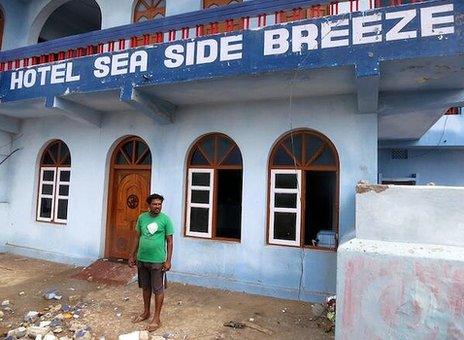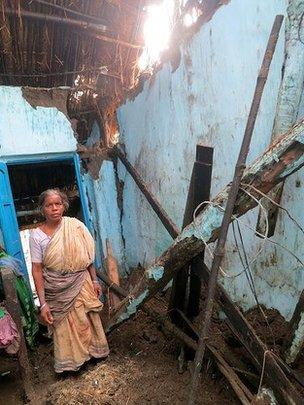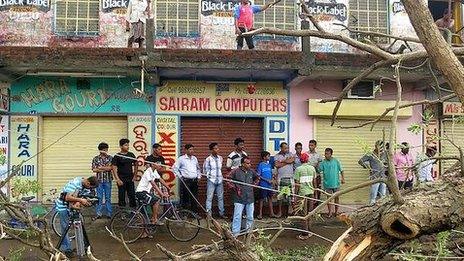Rare praise as India cyclone catastrophe averted
- Published

Krishna surveys the damage to his hotel in Gopalpur. Pictures: Andrew North
Few were closer to Cyclone Phailin when it hit land than the manager of the wonderfully-named Hotel Seaside Breeze.
The waves break right in front of the blue-painted hotel on Gopalpur's sea front and were "right on top" when the storm reached its peak on Saturday night, said Krishna.
Having lived through the deadly super-cyclone that tore through this region 14 years ago, he had no doubt this one was more powerful.
Yet Phailin is becoming better known for what it didn't do - thereby earning the Indian authorities some rare praise for their preparedness.
What may also have minimised its impact is that the cyclone came inland at low tide, reducing the chances of a devastating surge.
With power lines down and many homes and fields destroyed, it has still wreaked plenty of havoc - and at least 18 people are reported to have died.

Lakhmi Behra's home has been badly damaged
But more than 10,000 perished in 1999, and with the dire warnings preceding this storm many people feared similar casualties.
The Orissa state government, helped out by Delhi, surprised many by reacting early - sounding the alarm and organising mass evacuations along the coastal belt.
"A cynical nation has reason to hope," said Barkha Dutt, a well-known Indian TV journalist, praising the official response through her Twitter feed, external. "The system can work sometimes."
After the beating the authorities took for their handling of the summer floods in the northern state of Uttarakhand, in which thousands died, they didn't want to be caught out again. Extra air force and army units were put on standby to help.
The vast improvement in communications since 1999 also helped spread warnings about the storm. Even in poorer states like Orissa, most adults now have mobile phones and access to television, which was broadcasting increasingly alarming predictions as the cyclone worked its up the Bay of Bengal.
Krishna was one of those who opted to stay put - instead locking wooden shutters across his windows and sitting out the cyclone inside the Seaside Breeze.
The next day, he emerged to find a few chunks of the upper floor on the ground but otherwise the building was still intact.
There was no such welcome for Lakhmi Behra when she arrived home in the coastal village of Haripur, after being evacuated a few days ago.
She lived through the 1999 cyclone too. But this time the damage has been far worse, she says, pointing at gaping holes torn in her roof and walls.
"My home is broken and everything is gone. What do I do?"
A widow, she subsists on 50 rupees ($0.80; 50p) a day selling fish.

Storm damage in Berhampur will take some clearing up
As so often in any natural disaster, it's the poorest, living in the weakest homes and with the least resources, who tend to pay the heaviest price.
Despite the undoubtedly lower casualties from Cyclone Phailin, there are signs of some after-the-event inflation going on, with ever larger claims being made for the numbers evacuated. A few days ago it was 400,000, now it has become nearly a million.
Whatever the true figure, the authorities have come out looking better here.
Many Indians are already expressing astonishment that more people died in a stampede at a religious festival over the weekend than in what was billed as the worst cyclone in decades.
But although it could have been much worse, there are many thousands of people who still need help.
The challenge for the government now is to follow through with the clear-up and reconstruction.
- Published25 January 2013
- Published3 August 2012